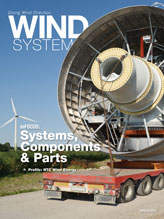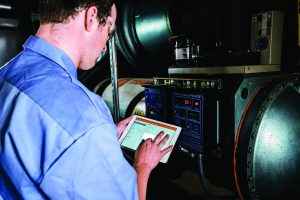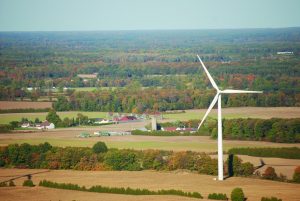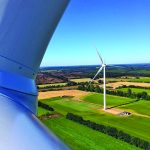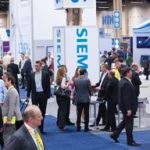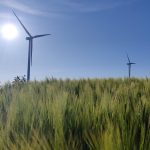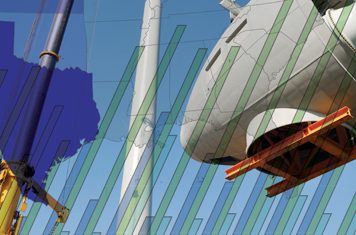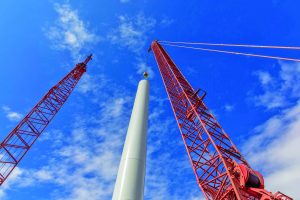The major issue for premature failure in wind-turbine gearboxes is bearing failure, which leads to gearbox failure. A wind-turbine gearbox will not survive if the oil is not clean and especially if the hard ferrous particles are not removed from around the bearings.1
The LaserNet 230 particle counter and ferrous debris monitor has been shown to be an excellent analytical tool for end users to diagnose wear faults in various machine applications such as gearboxes, engines, and transmissions. The wear generated in a wind-turbine gearbox is a function of load, speed, and lubricant condition. The lubricant must be correctly specified for the turbine gearbox’s idealized operating load and speed, and its condition must be carefully monitored in order to maintain the required lubricant film thickness in these regimes.

Ever-changing wind conditions and large variations in climates make wind-turbine condition monitoring extremely challenging. As a result, careful continuous automated monitoring of these critical and expensive assets is required. The National Renewable Energy Laboratory (NREL) uses the Lasernet Fines (LNF) technology in drive-train wind-turbine monitoring. It has demonstrated and recommended that condition-monitoring using the LNF is critical to avoiding premature failures in wind turbines.2
Existing particle counter/auto sampler setups are not ideally suited for processing heavy batches of wind-turbine oil samples that also can vary considerably in contamination level. Extra dilution steps for the viscosity and the contamination levels are required, making them unsuitable compared to the standard clean oil hydraulic applications they were initially designed for.
Gearbox Wear Particles
The abnormal wear generated in any gear system typically comes from the pitch line of the gear tooth (fatigue) or the tip of the gear (severe sliding). At the pitch line, the contact is rolling, so the particles will be similar to rolling contact fatigue particles. The gear contact has an increased sliding component as the root or tip is approached, and the particles will show signs of sliding morphology.

This morphological wear data is extremely beneficial to the end user, and abnormalities in the gearboxes caused by large particle generation are easily identifiable when trends are established that can distinguish ferrous from non-ferrous material. Another critical feature of a wind-turbine gearbox is the bearings are both on the low- and high-speed stages, and any misalignment of these will induce failure.

High Throughput
Online techniques are offered as site solutions for customers with multiple windfarms, but the se are costly and not sensitive enough. Centralizing the testing analysis by sending samples to a regional service center offers the best cost to monitoring benefit when large volumes of turbine samples are involved. Contract labs with the right high-throughput screening tools are well-equipped to turn around data quickly and can recommend further action and/or testing if necessary.
In a high sample-throughput scenario, such as a contract lab running more than 100 samples per day, it’s important to be able to screen samples accurately so a more thorough and in-depth ferrography analysis can be done on those select samples that show abnormal LNF/ferrous readings.
Ferrography is still one of the leading root-cause analysis techniques, but it requires a complimentary screening methodology that closely links particle size distributions, morphology, and ferrous content.
LaserNet 230 and ASP Combination
By coupling a fully equipped LaserNet 230 with ferrous capability to an automatic sample processor (ASP), a full tray of 24 heavy (320cSt) wind-turbine gear-oil samples can be analyzed in about 2 1/2 hours. This continuous operation includes sample preparation and system cleaning. This all can be accomplished with no operator intervention and can yield the following results:
- Particle distribution greater than 4um (ISO 4,6,14 Codes)
- Wear Shape classification and distribution greater than 20um (p/ml)
- Percentage of large ferrous greater than 20um (p/ml)
- Total ferrous (ppm)
- Free water (Additional information on free water contamination present in the gearbox can also be reported from the water droplet classification.)
Analyzing Heavy Gearbox Oils
The ASP has been uniquely designed to complement the LaserNet 230 by using stir-and-wash sequences used to simulate the typical manual sample preparation steps like shaking and rinsing during routine LNF analysis.
The particles in the sample are homogenized using a special stir motor that rotates at an optimally selected speed. The stirring creates a vortex effect in the oil that sucks the particles from the bottom of the bottle and into the sample volume creating a homogenized sample. The speed is selected so as not to introduce excessive bubbles into the sample (the LaserNet 230 easily classifies bubbles greater than 20um and does not count them).

The stirring method using the ASP is ideally suited for heavy gear oils compared to manual shaking on a standalone system. The viscous forces of the heavy oil make manual shaking and homogenization of the particles impossible. The remaining bubbles left in the bottle also take a much longer time to be removed by vacuum degassing or ultrasonic methods.
Once the sample has been stirred, the contamination on the stirrer and sipper are cleaned using solvent spray jets in the wash tanks. The stirrer is then spin dried, so it will be ready for the next sample.
By running samples in this exact same mechanical manner over and over, the repeatability from sample to sample is excellent, and any deviation in sample data from a well-established trend can easily be identified by an analyst.

Continuous operation of the ASP/LaserNet 230 system is important when dealing with hundreds of gearbox samples a day with various levels of wear and contamination. In a typical batch of wind-turbine gearbox samples, it’s not uncommon to have high levels of water or additive breakdown often being reported as greater than 2 million particles. The LNF imaging system can easily handle such high levels of contamination without any issues, but it’s important that the next sample is not cross-contaminated.
This is achieved by using a specially developed dynamic flush sequence that varies the amount of flushing required by continuously monitoring the particle count as the flush is taking place. A cleanliness threshold is set in the software, and once the count gets below this value, the flush stops, and the sample progresses. This is important as a typical wind-turbine gearbox running on a relatively new oil may only contain 1,300 to 10,000 parts per milliliter or an ISO code from 18 to 20. The incorporation of a bubble valve into the ASP flush line simulates a manual operator adding pockets of air shown to dramatically speed up flushing. It also removes excessive contamination quicker than a straight stream of solvent.
Conclusion
The ASP/LaserNet 230 ferrous combo is an ideal screening solution for wind-turbine gearbox applications where sample volumes are high. The system can accurately and repeatedly identify problem samples from a trend based on particle-size distributions. The source of the wear can be identified using the shape classifier and the ferrous information.
References
- Andy Milburn; Milburn Engineering, Wind Turbine Gearbox Wear and Failure Modes and Detection Methods, NREL — Wind Turbine Condition Monitoring Workshop — September 19-21, 2011.
- Shawn Sheng; NREL, Investigation of Various Wind Turbine Drivetrain Condition Monitoring Techniques — 2011 Wind Turbine Reliability Workshop, August 2-3, 2011, Albuquerque, New Mexico.
















